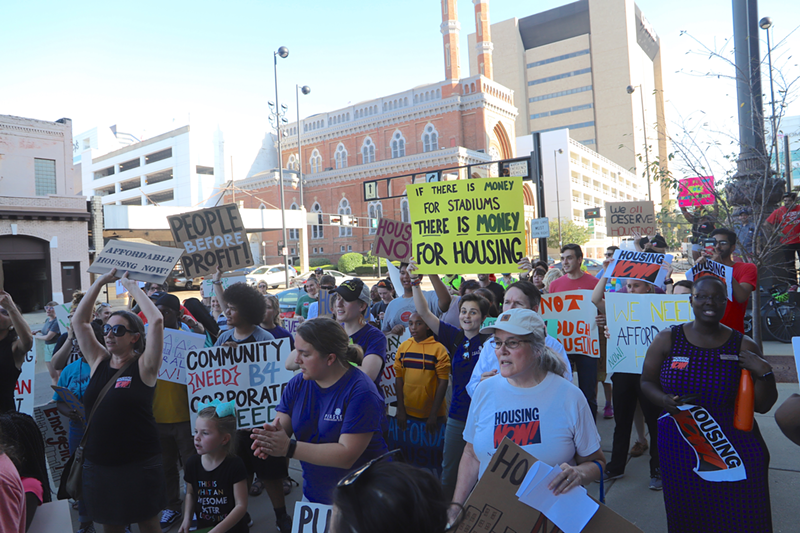Housing advocates who organized a march on Oct. 2 from the West End to Cincinnati City Hall to push for more affordable housing funding had a surprise for the more than 100 people who turned out for the event: the announcement of a citywide ballot initiative that, if successful, would direct the city to put $50 million to $100 million in its affordable housing trust fund every year.
Organizers say that fund could help prevent homelessness — advocates taped to City Hall the names of more than 600 people who died of causes related to being without a home during the rally — and people who find themselves in situations like the one Daniel Eubanks faces now, or the one Robin Wright faced growing up.
Eubanks must leave his apartment soon because his building sold, and could find himself without a home again after 15 years. Despite holding a Section 8 voucher, he says he can't find an apartment.
"I'm about to lose my housing and my voucher," he said. "I climbed up out of the cracks of Cincinnati, and here I go again. This is a serious issue."
Wright told the crowd that her family lived in their car when she was a teenager after they lost their apartment in Avondale to redevelopment.
"I'll never forget the day when my mom had to decide whether she would separate my brother, who was too old to go to the family shelters, from the rest of the family so we could go to the shelters or whether we would sleep in our car," she said. "We slept in the car, just so you know. There was nowhere else to go. This is a fixable problem. We can invest in a housing fund. We can require every new development to have some affordable housing. City governments are working to alleviate homelessness elsewhere."
Stories like Wright's aren't uncommon, those who run shelters say, thanks to a lack of affordable housing.
"Too often homeless families are invisible," says Susan Schiller of family shelter Bethany House. "But the numbers are real and the needs are great." The shelter serves more than 300 families a year, including 800 children. Schiller says 57 percent of families who call shelters in Cincinnati are turned away due to lack of capacity.
"Forty thousand units short," the crowd chanted as it marched from Laurel Park, where there was a cookout and singing, down Central Parkway to City Hall. "Where is City Hall support?"
There have been movements in the direction of helping facilitate more housing from City Hall. Councilmember David Mann in December helped push the creation of an affordable housing trust fund, a move allowed by a state law passed in 1991. The Ohio Housing Trust Fund, which currently gets roughly $46 million a year from the state, was founded in 1994.
"It took the city of Cincinnati nearly 30 years to establish the housing trust fund," Over-the-Rhine Community Housing Executive Director Mary Burke Rivers said. "We're grateful for that, but we're not going to wait another 30 years to have it funded properly."
Columbus established a municipal housing fund about two decades ago. This May, Columbus voters approved a bond issue that will generate $50 million for affordable housing, Franklin County paid $17 million into the fund, and private investment from banks and other corporations poured $100 million into another fund for affordable housing.
Cincinnati's fund currently has roughly $611,000 in it. That's enough for potentially seven units of housing, advocates say — or less. The median cost nationally for a unit of housing built with federal Low Income Housing Tax Credits between 2011 and 2016 was $165,000, according to the National Council of State Housing Agencies.
"We worked really hard for a long, long time to create an affordable housing trust fund," said Affordable Housing Advocates President John Schrider. "We finally got city council to do it. But now, we're taking the first step to making that thing real, because we're going to get real money in the trust fund, and with that money, we're going to solve the housing problem once and for all in this city."
There is an estimated 28,000-unit gap in housing affordable to low-income people in Cincinnati and a 40,000-unit deficit across Hamilton County. Those figures, cited by the Ohio Housing Finance Agency last year in a presentation to city council, can be found in a study by Local Initiatives Support Corporation of Greater Cincinnati.
The proceeds from the proposed ballot initiative — for which supporters would need to gather more than 6,000 signatures by next summer to get it on the November 2020 ballot — would build at most 500 to 1,000 new units of housing directly each year, or could be leveraged to win LIHTC or other tax credits or used to incentivize affordable housing units in market-rate projects.
Greater Cincinnati Homeless Coalition Director Josh Spring says the coalition responsible for the ballot initiative idea is working on suggestions for possible ways the city could raise the money, but has not finalized them yet.
Federal guidelines suggest housing is affordable if an individual or family is paying less than 30 percent of their income for it. Under the ballot initiative language, half the money raised would be required to go to housing affordable to people making no more than 60 percent of the county's Area Median Income (about $26,400 a year for a single person) and the other half would go to housing for people making less than 30 percent AMI (about $13,000 a year for a single person — roughly the median household income of the West End). The money would be administered by a board made up of community members.
To give a sense of the scale of the ask, $50 million is roughly the same amount a .3 percent portion of the city's 2.1 percent earnings tax currently raises every year to fund the region's Metro bus service.
That amount of money could be a very heavy political lift, especially given the city's budget shortfalls in recent years.
But Rev. Nelson Pierce of the Beloved Community Church told the crowd that advocates won't wait.
"Elected officials make promises to the people, but when it comes time to deliver on those promises, we find the doors closed in our face and those people are nowhere to be found," he said. "But I've come here today to say no more. This time we're putting the trust in our hands. We're putting the issue directly on the ballot. We're not looking for anyone to save us. We're going to save ourselves."
The rally at City Hall was organized by a number of groups working on homelessness prevention, tenant advocacy, affordable housing and related causes, including Caracole, Tender Mercies, Lighthouse Youth and Family Services, Bethany House Services, Shelterhouse, Over-the-Rhine Community Housing, Interfaith Hospitality Network of Greater Cincinnati, advocacy groups like the Greater Cincinnati Homeless Coalition and Affordable Housing Advocates, religious organizations like the Metropolitan Area Religious Coalition of Cincinnati, New Prospect Baptist Church, First United Church of Christ, Christ Church Cathedral and a number of other organizations.






